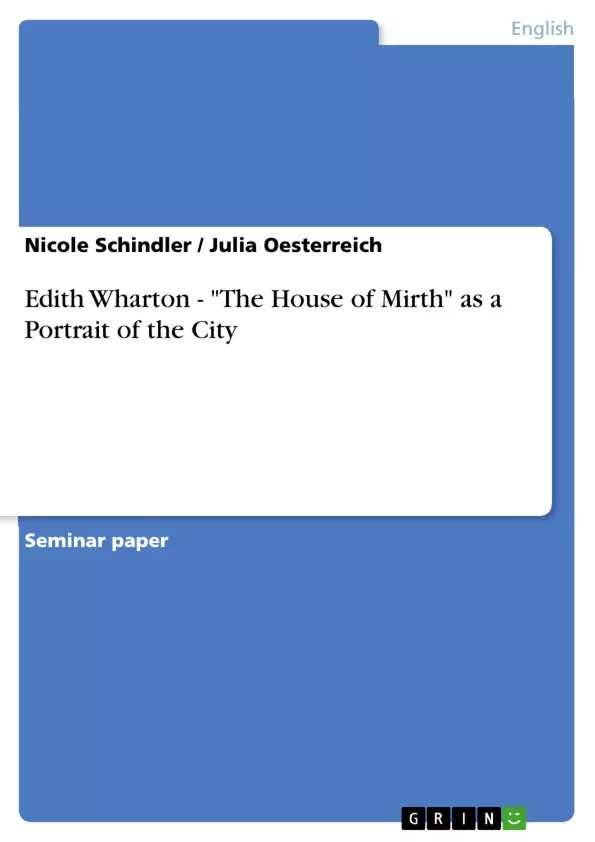In this paper we will describe the ambivalent relationship between American novelist Edith Wharton and the American city. Wharton is concerned with the lives of a rather closed set of people, namely the so called “old families” of New York. In Wharton's works, the world of the working poor is an invisible one. Although employees, servants, and maids were constantly present in and around the houses of the so called leisure class, they do not gain an independent voice, their struggle is being left untold. Wharton is interested in how the people she understood best, the families who inhabited society's highest valued spots, managed their situation. Edith Wharton’s view of the architectural status quo and the newest developments in her city has to be called ambiguous. She relished the Beaux Art architecture of grandeur and at the same time she despised everything that screamed newly-rich to her. Anti-Semitism is a topic in this paper, because it became a component of New York’s bourgeois identity as wealthy Jewish families were perceived to present a challenge to this high status group.
Questions we were, amongst others, concerned with are: What effect had the modern city life on the best established class? How were the customs and modalities of these people affected by the tremendous developments around them? And how did (gendered) individuals react to the entrance wish of the newly rich into their inner circles? In other words, the way in which in- and exclusion from a certain group worked, how these were executed and what the potentiality of a change in status meant for the mind of the involved characters is Edith Wharton's central concern.
Inhaltsverzeichnis (Table of Contents)
- Introduction: Edith Wharton and New York City
- The American City in Novels
- Social Customs of the Wealthy
- Edith Wharton's Qualification to write about New York Society
- Architecture
- Luxury
- Rites and Rituals
- New Money - New Rules
- Conclusion
- Sources
Zielsetzung und Themenschwerpunkte (Objectives and Key Themes)
This paper aims to explore the complex relationship between American novelist Edith Wharton and the American city, particularly focusing on her portrayal of New York City society in her novels. The paper examines how Wharton's personal experiences and observations shaped her writing and provide insights into the social dynamics of the upper class during the Gilded Age.
- Edith Wharton's personal experiences and perspectives on New York society
- The portrayal of social customs and rituals of the wealthy in New York
- The impact of the rise of new money and its influence on established social hierarchies
- The role of women in New York society and their limited rights and freedoms
- The contrasting perspectives of the city as a symbol of both opportunity and constraint
Zusammenfassung der Kapitel (Chapter Summaries)
- Introduction: Edith Wharton and New York City: This chapter introduces Edith Wharton and her personal connection to New York City. It discusses her background, her experiences with the city's social life, and the influence of her upbringing on her writing. The chapter also provides context by discussing the transformation of New York City during the Gilded Age and the changing social landscape.
- The American City in Novels: This chapter explores the role of the city in American literature, specifically highlighting the contrasting perspectives of authors like Theodore Dreiser and Stephen Crane who focused on the lives of working-class individuals. The chapter contrasts these perspectives with Wharton's approach to the city, which primarily focuses on the upper class and their experiences within this world.
- Social Customs of the Wealthy: This chapter delves into the intricate social customs and rituals that governed the lives of the upper class in New York City during Wharton's time. It examines the importance of tradition, status, and social expectations within this closed circle and how these factors influenced individual actions and choices.
- Edith Wharton's Qualification to write about New York Society: This chapter analyzes Wharton's unique position as a writer who had intimate knowledge of the New York upper class. It highlights her ability to observe and portray the complexities of this society based on firsthand experience. The chapter explores the role of her privileged background in shaping her understanding and perspectives on the dynamics of this social world.
Schlüsselwörter (Keywords)
This paper focuses on the intersection of social dynamics, gender roles, and urban environments. Key terms and concepts include Edith Wharton, New York City, Gilded Age, upper class, social customs, wealth, social hierarchies, gender roles, and the American city as a symbol of both opportunity and constraint.
- Quote paper
- Nicole Schindler (Author), Julia Oesterreich (Author), 2005, Edith Wharton - "The House of Mirth" as a Portrait of the City, Munich, GRIN Verlag, https://www.grin.com/document/69474



